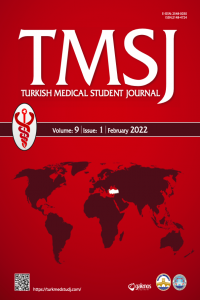USE OF ELECTROCARDIOGRAPHIC MARKERS TO PREDICT VENTRICULAR ARRHYTHMIAS IN ACUTE MYOCARDITIS PATIENTS
USE OF ELECTROCARDIOGRAPHIC MARKERS TO PREDICT VENTRICULAR ARRHYTHMIAS IN ACUTE MYOCARDITIS PATIENTS
Aims: Acute myocarditis is an inflammatory disease of the myocardium and is characterized by a large heterogeneity of clinical presentation. Myocarditis is becoming to be recognized as a contributor to unexplained mortality, and is thought to be a major cause of sudden cardiac death in the first two decades of life. Myocardial inflammation, ion channel dysfunction, electrophysiological and structural remodelling may play important roles in life-threatening arrhythmias. We aimed to investigate the ventricular arrhythmia predictors in myocarditis patients by using electrocardiographic markers. Methods: A total of 56 patients (mean age 22.5 ± 3.7 years; 89% males) with acute myocarditis were enrolled in the study. Tpeak-Tend intervals, Tpeak-Tend/QT and Tpeak-Tend/corrected QT (QTc), cardio-electrophysiological balance (QT/QRS) and heart rate-corrected QT(QTc)/QRS ratios were calculated from 12-lead electrocardiogram. Results: Heart rate, QT and QTc values were similar between groups. QRS complexes were lower in arrhythmia positive group than arrhythmia negative group (p=0.004). Tpeak-Tend intervals, Tpeak-Tend/QT, Tpeak-Tend/ QTc, cardio-electrophysiological balance and heart rate-corrected QT(QTc)/QRS values were significantly higher in arrhythmia positive group (< 0.001, < 0.001, p=0.03, p=0.04 and < 0.001, respectively). Conclusion: In this study, we observed that higher Tpeak-Tend, Tpeak-Tend/QT, Tpeak-Tend/QTc , cardio-electrophysiological balance (ICEB) and heart rate-corrected QT(QTc)/QRS ratio are associated with ventricular arrhythmic episodes in acute myocarditis patients. These electrocardiographic markers may be beneficial to identify high risk patients for arrhytmias complicating myocarditis.
Keywords:
Arrhythmia, electrocardiography, myocarditis,
- ISSN: 2148-4724
- Başlangıç: 2014
- Yayıncı: Trakya Üniversitesi
Sayıdaki Diğer Makaleler
KNOWLEDGE OF CLINICAL STUDENTS REGARDING PANDEMIC H1N1 INFLUENZA
Zainab Akmal Abbasi, Moazzam Ali, Syed MuhammadAli Shah
USE OF ELECTROCARDIOGRAPHIC MARKERS TO PREDICT VENTRICULAR ARRHYTHMIAS IN ACUTE MYOCARDITIS PATIENTS
Öznur Yumurtacı, Cansu Kurt, Fatih Mehmet Uçar, Cihan Öztürk
THE AGE AND GENDER PRESENTATION IN THE FORMATIONS OF GALLSTONES
Hande Sevinç, Merve Sena Demir, Canan Mercan, Filiz Yüksel, Ayşe Çaylan
A CASE REPORT: ICTAL BRADYCARDIA IN A PATIENT WITH SYNCOPAL ATTACKS
